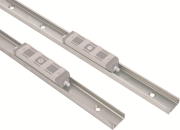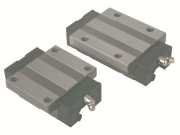For more than 50 years the UK manufacturing industry has been embracing automation in an attempt to improve productivity and efficiency. A key enabler of this is automatic production lines, which design engineers are continuously developing to enable better performance and longevity. Whilst many of today’s control and automation systems are delivering functional reliability for many years, a number of older systems are becoming obsolete, expensive to maintain, and in many cases, difficult to support. Investing in like-for-like replacements is costly and the time it takes to install these can lead to significant downtime. Marcus Schneck, CEO at norelem UK has an alternative solution – stripping the design of automated systems down to a more simplified level, and re-building effective, longer-lasting machines using standard components
“There’s a huge misconception in the industry that standard components can never provide the same high precision as more bespoke products, but this is not the case,” he explains. “If you take roller guide rails as an example, these provide a very high precision method of moving a product from one point to another, via a carriage. They’re often used in material feed assembly, automation technology, and jig and fixture construction, because of their robustness and rigidity. Not only do they allow accelerations of up to five metres per second, carrying materials of up to 12,280 Newtons, but by using a combination of fixed and floating rails, it is possible to create the necessary tolerance compensation to prevent tilting and excessive wear during parallelism errors. By adjusting the guide carriage backlash free, via an eccentric, a more precise run can be created.”
norelem’s view is not necessarily that large factories should adopt standard components en-masse in an attempt to create more affordable longer lasting assembly lines, but that standard components can provide a more affordable and effective solution for much smaller machine building and automation challenges. For smaller manufacturing businesses, any improvement in productivity that can be achieved through automation is a marginal gain that will have a much larger impact on performance and profitability. Not only do standard components offer a more affordable option for design engineers creating these systems, but they can reduce lifecycle costs since very little maintenance is required.
Marcus Schneck continues: “One of the biggest barriers to adopting automation and new machinery is the high costs associated with not only purchasing, but maintaining these systems as well. For production lines in the food industry and flour mills, there is also a risk of duct clogging up the rails of the system, but there are lots of configurations you can make with standard components to overcome this. Using slide guide rails manufactured using polymeric materials can enable design of a system which is resistant to dust and suited to dry running. In particular, roller bearings have a life-time lubrication and are sealed on both sides to protect against dirt particles. Furthermore, grease nipples can be used to wet the tread with a lubricating film for even higher performance.”
Speeds of up to seven metres a second can be achieved with roller guide systems, which are typically used wherever assemblies have to be moved along a linear axis, for example machine construction, medical technology, automation and logistics equipment. Whilst roller guide bearings have a fixed bearing, they can be adapted to change the design friction, enabling design engineers to build more bespoke systems. norelem provides the example of a small electronics assembly line to demonstrate how standard components can be used to enable automated production.
In this example, an engineer may want to build a circuit board on a rail with a cellular system to automate the production process. At one end of the work holding table an electric motor will be installed to enable the guide rails to move the circuit board along the fitters for each stage of production, allowing each operative to perform their individual task. This could accommodate 4-5 operations over the length of the rail. At the final stage, the rails will move the completed circuit off the production line and into a storage area. The alternative solution in this situation would be to use a conveyor belt. The drawback of this approach is that it is considerably more expensive than a system that has been assembled using standard components.
Marcus Schneck explains: “In the instance outlined above, the only solution required is a mechanism to put a slide rail into a facility or machine that is low maintenance and can cost effectively move a product. One designed using standard components perfectly suits the environment in which it is expected to perform.”
Talking to Marcus, it is very easy to understand the benefits that standard components can deliver to small automated production lines, satisfying the requirements of smaller engineering businesses. What you can’t help but wonder though, is how effective standard components would be in a scaled-up environment. Although rarely used in this context, Marcus believes that they could still offer a solution.
“In a connected factory setting, you may have an operative working in an enclosure with a robot, which needs to put a product on a rail to move it, with the rail stopping at various points throughout the process for more assembly work. Each robot on the track would perform a duty before the product moves a matter of inches to the next robot in the production line. A combination of slide guide rails and stepper motors could facilitate this automated operation cost effectively, but a design engineer would still have to be able to write and activate sophisticated code to enable this to happen.”
While standard components are better suited to smaller factory environments, they are hard to beat for design engineers seeking an affordable, practical, and effective, low maintenance solution. They also solve the common industry problem of misalignment, since a fixed bearing used in combination with a floating bearing can further increase levels of accuracy. Perhaps the biggest advantage of standard components in this scenario though, is the fact they are so widely available.
Marcus Schneck summarises: “Standard components are widely available and easy to purchase. At norelem we have a range of more than 33,000 standard components available in THE BIG GREEN BOOK, which can be ordered from stock. When more sophisticated systems fail, pinpointing the exact cause can be difficult and time consuming. Downtime caused by aging systems has a major impact on production and when obsolete control and automation components are found, they often come at a premium. Standard components come readily available and are priced affordably, delivering a more streamlined and longer-term solution for many smaller manufacturing businesses.”
Workholding accessories can be found in THE BIG GREEN BOOK from norelem, which can be ordered at https://www.norelem.co.uk/gb/en/Download/eCatalog.html

